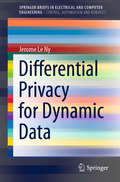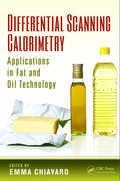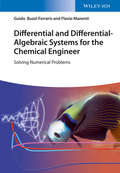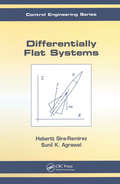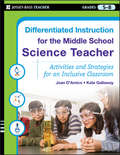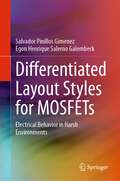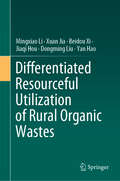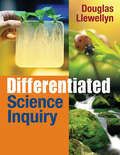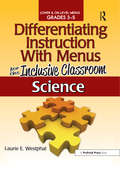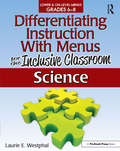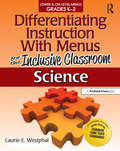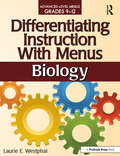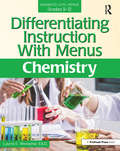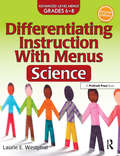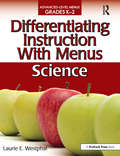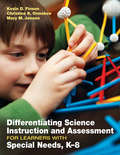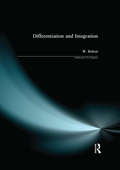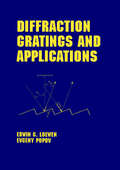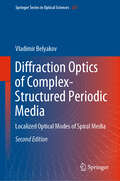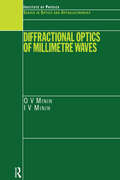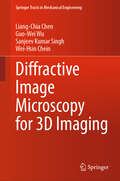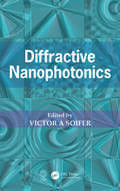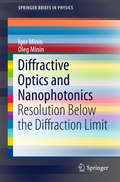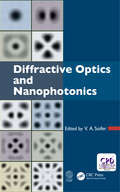- Table View
- List View
Differential Privacy for Dynamic Data (SpringerBriefs in Electrical and Computer Engineering)
by Jerome Le NyThis Springer brief provides the necessary foundations to understand differential privacy and describes practical algorithms enforcing this concept for the publication of real-time statistics based on sensitive data. Several scenarios of interest are considered, depending on the kind of estimator to be implemented and the potential availability of prior public information about the data, which can be used greatly to improve the estimators' performance. The brief encourages the proper use of large datasets based on private data obtained from individuals in the world of the Internet of Things and participatory sensing. For the benefit of the reader, several examples are discussed to illustrate the concepts and evaluate the performance of the algorithms described. These examples relate to traffic estimation, sensing in smart buildings, and syndromic surveillance to detect epidemic outbreaks.
Differential Scanning Calorimetry: Applications in Fat and Oil Technology
by Emma ChiavaroDifferential Scanning Calorimetry: Applications in Fat and Oil Technology provides a complete summary of the scientific literature about differential scanning calorimetry (DSC), a well-known thermo-analytical technique that currently has a large set of applications covering several aspects of lipid technology. The book is divided into three major s
Differential and Differential-Algebraic Systems for the Chemical Engineer
by Guido Buzzi-Ferraris Flavio ManentiThis fourth in a suite of five practical guides is an engineer's companion to using numerical methods for the solution of complex mathematical problems. It explains the theory behind current numerical methods and shows in a step-by-step fashion how to use them.The volume focuses on differential and differential-algebraic systems, providing numerous real-life industrial case studies to illustrate this complex topic. It describes the methods, innovative techniques and strategies that are all implemented in a freely available toolbox called BzzMath, which is developed and maintained by the authors and provides up-to-date software tools for all the methods described in the book. Numerous examples, sample codes, programs and applications are taken from a wide range of scientific and engineering fields, such as chemical engineering, electrical engineering, physics, medicine, and environmental science. As a result, engineers and scientists learn how to optimize processes even before entering the laboratory.With additional online material including the latest version of BzzMath Library, installation tutorial, all examples and sample codes used in the book and a host of further examples.
Differentially Flat Systems (Automation and Control Engineering #Vol. 17)
by Sunil K. Agrawal Hebertt Sira-RamírezIllustrating the power, simplicity, and generality of the concept of flatness, this reference explains how to identify, utilize, and apply flatness in system planning and design. The book includes a large assortment of exercises and models that range from elementary to complex classes of systems. Leading students and professionals through a vast array of designs, simulations, and analytical studies on the traditional uses of flatness, Differentially Flat Systems contains an extensive amount of examples that showcase the value of flatness in system design, demonstrate how flatness can be assessed in the context of perturbed systems and apply static and dynamic feedback controller design techniques.
Differentiated Instruction for the Middle School Science Teacher
by Joan D'Amico Kate GallawayAn indispensable guide for middle school science teachers who have inclusive classrooms The third volume in the Differentiated Instruction series, Differentiated Instruction for the Middle School Science Teacher offers teachers proven techniques for designing and delivering effective science instruction, measuring success, getting students to work together, and collaborating with other professionals. The ready-to-use activities are tied to core curriculum standards for middle school students and each lesson incorporates adaptations for students with different learning needs. Includes strategies for teaching a standards-based science curriculum Contains a wealth of activities that can be adapted for learners of all abilities Offers information for delivering effective instruction, measuring success, and student collaboration The authors, both experienced teachers, offer a range of techniques, such as station/group activities, enrichment activities, and modifications for students with specific disabilities.
Differentiated Layout Styles for MOSFETs: Electrical Behavior in Harsh Environments
by Salvador Pinillos Gimenez Egon Henrique GalembeckThis book describes in detail the semiconductor physics and the effects of the high temperatures and ionizing radiations in the electrical behavior of the Metal-OxideSemiconductor Field Effect Transistors (MOSFETs), implemented with the first and second generations of the differentiated layout styles. The authors demonstrate a variety of innovative layout styles for MOSFETs, enabling readers to design analog and RF MOSFETs that operate in a high-temperature wide range and an ionizing radiation environment with high electrical performance and reduced die area.
Differentiated Resourceful Utilization of Rural Organic Wastes
by Beidou Xi Mingxiao Li Xuan Jia Jiaqi Hou Dongming Liu Yan HaoThis book systematically introduces the key technologies for differentiated resourceful utilization of rural organic wastes based on high-efficiency anaerobic fermentation and bio-augmented composting, and discusses differentiating sources of organic wastes, integrating recycling technologies, developing key equipment, and researching management mechanisms. In addition, it describes the development of viable techniques and low-pollution, low-cost, and low-maintenance equipment. It also includes the technical specifications for the differentiated resourceful utilization of rural organic wastes and presents the energy-fertilizer integrated resourceful utilization method for rural organic wastes. Providing technological insights into improving the resourceful utilization level of rural organic wastes, this book is a valuable reference resource for administrative staff, researchers in the field of environmental protection, and technicians in enterprises involved in the treatment and disposal of solid wastes.
Differentiated Science Inquiry
by Douglas J. LlewellynIgnite science learning with differentiated instruction One type of science instruction does not fit all. Best-selling author Douglas Llewellyn gives teachers standards-based strategies for differentiating science education to more effectively meet the needs of all students. This book takes the concept of inquiry-based science instruction to a deeper level, includes a compelling case study, and demonstrates: Methods for determining when and how to provide students with more choices, thereby increasing their ownership and motivation Ways to implement differentiated science inquiry in the main areas of science instruction Strategies for successfully managing the classroom
Differentiating Instruction With Menus for the Inclusive Classroom: Science (Grades 3-5)
by Laurie E. WestphalDifferentiating Instruction With Menus for the Inclusive Classroom: Science for grades 3-5 offers teachers everything they need to create a student-centered learning environment based on choice. This book provides six different types of menus that students can use to select exciting products that they will develop so teachers can assess what has been learned—instead of using a traditional worksheet format. Topics addressed include physical science, biological science, Earth science, and tools scientists use.Differentiating Instruction With Menus for the Inclusive Classroom: Science provides numerous types of leveled menus that lower and on-level elementary-aged students can use to demonstrate learning through a method of their choice. Menus with similar formats but geared towards varying ability levels allow teachers to differentiate easily. Using the creative and challenging choices found in Tic-Tac-Toe menus, List menus, 2-5-8 menus, Three Shape menus, Baseball menus, and Game Show menus, students will look forward to sharing their newfound knowledge throughout the year. Also included are specific guidelines for products, rubrics for assessing student products, and teacher introduction pages for each menu. This is a must-have for any teacher wanting to differentiate for a wide range of learners!Grades 3-5
Differentiating Instruction With Menus for the Inclusive Classroom: Science (Grades 6-8)
by Laurie E. WestphalDifferentiating Instruction With Menus for the Inclusive Classroom: Science for grades 6-8 offers teachers who have multiple ability levels in one classroom everything they need to create a student-centered learning environment based on choice. For each topic covered, there are two menus that look similar but contain differentiated content: one menu for students working on grade level and the other for students working below grade level. Using the creative, challenging choices found in Tic-Tac-Toe menus, List menus, 2-5-8 menus, and Game Show menus, students will demonstrate their knowledge with unique, exciting products. Also included are specific guidelines for products, assessment rubrics, and teacher introduction pages for each menu. These menus can also be used in conjunction with the Differentiating Instruction With Menus series (for students working above grade level) for three tiers of complementary menus.Grades 6-8
Differentiating Instruction With Menus for the Inclusive Classroom: Science (Grades K-2)
by Laurie E. WestphalDifferentiating Instruction With Menus for the Inclusive Classroom: Science for grades K-2 offers teachers everything needed to create a student-centered learning environment based on choice. This book provides seven different types of menus that students can use to select exciting products that they will develop so teachers can assess what has been learned instead of using a traditional worksheet format. Topics addressed include life sciences, Earth sciences, and physical sciences. Differentiating Instruction With Menus for the Inclusive Classroom: Science provides numerous types of leveled menus that lower and on-level primary-age students can use to select exciting products to demonstrate learning. Menus with similar formats but geared toward varying ability levels allow teachers to differentiate easily. Using the creative and challenging choices found in Meal menus, Tic-Tac-Toe menus, Target-Based List menus, 2-5-8 menus, Give Me 5 menus, Three-Shape menus, and Pick 3 menus, students will look forward to sharing their newfound knowledge throughout the year. Also included are specific guidelines for products, rubrics for assessing student products, and teacher introduction pages for each menu. This is a must-have for any teacher wanting to differentiate for a wide range of learners!Grades K-2
Differentiating Instruction With Menus: Biology (Grades 9-12)
by Laurie E. WestphalDifferentiating Instruction With Menus: Biology offers teachers everything needed to create a student-centered learning environment based on choice. This book presents six different types of menus that students can use to select exciting advanced-level products that they will develop so teachers can assess what has been learned, instead of using a traditional worksheet format. Topics addressed include biology basics, biodiversity and environments, genetics, human body systems, and the different phyla typically included in the biology curriculum. Differentiating Instruction With Menus: Biology contains attractive reproducible menus, each based on the levels of Bloom's revised taxonomy as well as incorporating different learning styles. These menus can be used to guide students in making decisions as to which products they will develop after studying a major concept or unit.Grades 9-12
Differentiating Instruction With Menus: Chemistry (Grades 9-12)
by Laurie E. WestphalDifferentiating Instruction With Menus: Chemistry offers teachers everything needed to create a student-centered learning environment based on choice. This book uses different types of menus that students can use to select exciting advanced-level products that they will develop so teachers can assess what has been learned—instead of using a traditional worksheet format. Topics addressed include chemistry basics, measurements, atoms, chemical bonding and reactions, gas laws, energy, acids and bases, and nuclear and organic chemistry. Differentiating Instruction With Menus: Chemistry contains attractive reproducible menus, each based on the levels of Bloom's revised taxonomy as well as incorporating different learning styles. These menus can be used to guide students in making decisions as to which products they will develop after studying a major concept or unit.Grades 9-12
Differentiating Instruction With Menus: Science (Grades 3-5)
by Laurie E. WestphalThe best-selling Differentiating Instruction With Menus series has helped teachers nationwide differentiate instruction for their high-ability learners with easy-to-use menus and exciting tools to challenge and reach gifted and advanced students in the classroom. Each book includes an updated, student-friendly rubric that can assess different types of products, free choice proposal forms to encourage independent study, and new and favorite challenging menus to meet the needs of these diverse higher level learners. Readers will also be able to save time by using updated guidelines that reflect changes in technology for each of the products included in the menus and find direct alignment with standards approved in recent years. Topics addressed in Differentiating Instruction With Menus: Science (Grades 3-5, 2nd ed.) include physical science, biological science, Earth science, and scientists and the tools they use.Grades 3-5
Differentiating Instruction With Menus: Science (Grades 6-8)
by Laurie E. WestphalThe best-selling Differentiating Instruction With Menus series has helped teachers nationwide differentiate instruction for their high-ability learners with easy-to-use menus and exciting tools to challenge and reach gifted and advanced students in the classroom. Each book includes an updated, student-friendly rubric that can assess different types of products, free choice proposal forms to encourage independent study, and new and favorite challenging menus to meet the needs of these diverse higher level learners. Readers will also be able to save time by using updated guidelines that reflect changes in technology for each of the products included in the menus and find direct alignment with standards approved in recent years. Topics addressed in Differentiating Instruction With Menus: Science (Grades 6-8, 2nd ed.) include process skills, physical sciences, life sciences, and Earth and space sciences.Grades 6-8
Differentiating Instruction With Menus: Science (Grades K-2)
by Laurie E. WestphalThe Differentiating Instruction With Menus series offers teachers exciting tools to challenge and reach both gifted and advanced students in the classroom. Whether these students need enrichment, choice in independent practice, or even additional academic options resulting from curriculum compacting, these books provide teachers a complete ready-to-use resource. Each book includes a rubric that can assess different types of products, free choice proposal forms to encourage independent study, specific guidelines for each of the products included in the menus to save the teacher time, and challenging menus to meet the needs of these diverse higher level learners.Differentiating Instruction With Menus: Science (Grades K-2) contains attractive reproducible menus, based on the levels of Bloom's revised taxonomy, that students can use as a guide when making decisions about which products they will develop after they study a major concept or unit. Topics addressed include life science, Earth science, and physical science.The products included on the menu are carefully selected from various learning styles to build students' excitement and so that teachers can more accurately assess the depth of what has been learned. Using creative and challenging choices found in Three-Shape Menus, Tic-Tac-Toe Menus, Meal Menus, Give Me Five Menus, 2-5-8 Menus, and List Menus, students will look forward to sharing their newfound knowledge throughout the year!Grades K-2
Differentiating Science Instruction and Assessment for Learners With Special Needs, K–8
by Kevin D. Finson Christine K. Ormsbee Mary M. JensenField-tested strategies for teaching science to students with special needs This timely, practical guidebook shows general and special educators how to retool science activities and assessments for students with special needs. The authors cover a broad range of topics in an orderly, concise fashion, including: National and state requirements for science learning Pedagogical strategies for collaborative learning groups, individual contracts, self-paced learning centers, literature circles, and team projects Grade-appropriate ways to revise science activities and assessments Step-by-step instructions for using rubrics for evaluation, revision, and assessment Information on teacher collaboration and specific disabilities
Differentiation and Integration (500 Tips)
by W. BoltonThis book is concerned with the principles of differentiation and integration. The principles are then applied to solve engineering problems. A familiarity with basic algebra and a basic knowledge of common functions, such as polynomials, trigonometric, exponential, logarithmic and hyperbolic is assumed but reference material on these is included in an appendix.
Diffraction Gratings and Applications (Optical Science and Engineering)
by Erwin G. Loewen Evgeny Popov"Offers and up-to-date assessment of the entire field of diffraction gratings, including history, physics, manufacture, testing, and instrument design. Furnishes--for the first time in a single-source reference--a thorough review of efficiency behavior, examining echelles as well as concave, binary, transmission, fiber, and waveguide gratings."
Diffraction Optics of Complex-Structured Periodic Media: Localized Optical Modes of Spiral Media (Springer Series in Optical Sciences #203)
by Vladimir BelyakovThis book presents recent theoretical and experimental results of localized optical modes and low-threshold lasing in spiral photonic media. Efficient applications of localized modes for low-threshold lasing at the frequencies of localized modes are a central topic of the book's new chapters. Attention is paid to the analytical approach to the problem. The book focuses on one of the most extensively studied media in this field, cholesteric liquid crystals. The chosen model, in the absence of dielectric interfaces, allows to remove the problem of polarization mixing at surfaces, layers and defect structures. It allows to reduce the corresponding equations to the equations for light of diffracting polarization only. The problem concentrates then on the edge and defect optical modes. The possibility to reduce the lasing threshold due to an anomalously strong absorption effect is presented theoretically for distributed feedback lasing. It is shown that a minimum of the threshold-pumping wave intensity can be reached for the pumping wave frequency coinciding with the localized mode frequency (what can be reached for a pumping wave propagating at a certain angle to the helical axes). Analytic expressions for transmission and reflection coefficients are presented. In the present second edition, experimental observations of theoretically revealed phenomena in spiral photonic media are discussed. The main results obtained for spiral media are qualitatively valid for photonic crystals of any nature and therefore may be applied as a guide to investigations of other photonic crystals where the corresponding theory is more complicated and demands a numerical approach. It is demonstrated that many optical phenomena occurring at the frequencies of localized modes reveal unusual properties which can be used for efficient applications of the corresponding phenomena, efficient frequency conversion and low threshold lasing, e.g. For the convenience of the reader, an introduction is given to conventional linear and nonlinear optics of structured periodic media. This book is valuable to researchers, postgraduate, and graduate students active in theoretical and experimental physics in the field of interaction of radiation with condensed matter.
Diffractional Optics of Millimetre Waves
by I.V. Minin O.V. MininDiffractional Optics of Millimetre Waves combines those elements of diffraction theory normally associated with optics, including Gaussian beams, lenses, and mirrors, and extends them into the micro- and millimetre wavelength range. In this regime there are a number of applications in devices, such as automobile proximity sensors, satellite-TV receiving antennae, and non-destructive testing systems. Researchers working in these areas would benefit from greater understanding of the diffraction phenomena involved. A translated and updated version of the authors' book Diffraction Quasioptics, this book will present results formerly unavailable in the general literature.
Diffractive Image Microscopy for 3D Imaging (Springer Tracts in Mechanical Engineering)
by Sanjeev Kumar Singh Liang-Chia Chen Guo-Wei Wu Wei-Hsin CheinThis book presents a unique methodology of precious and original scientific work in optical microscopy that is scarce to be found elsewhere. It covers modern 3D optical microscopy to provide a solid understanding of microscopic optics and imaging theory. With an inspiring development in diffractive image microscopy and ANN-based reverse mapping modeling, this is an invaluable book for precision optics, precision metrology, optical testing, biomedical engineering, and physics students or staff taking R&D on optical microscopy, as well as advanced undergraduates, professionals, and researchers looking for an accessible introduction to the field.
Diffractive Nanophotonics
by Victor A SoiferDiffractive Nanophotonics demonstrates the utility of the well-established methods of diffractive computer optics in solving nanophotonics tasks. It is concerned with peculiar properties of laser light diffraction by microoptics elements with nanoscale features and light confinement in subwavelength space regions. Written by recognized experts in t
Diffractive Optics and Nanophotonics
by Igor Minin Oleg MininIn this book the authors present several examples of techniques used to overcome the Abby diffraction limit using flat and 3D diffractive optical elements, photonic crystal lenses, photonic jets, and surface plasmon diffractive optics. The structures discussed can be used in the microwave and THz range and also as scaled models for optical frequencies. Such nano-optical microlenses can be integrated, for example, into existing semiconductor heterostructure platforms for next-generation optoelectronic applications. Chapter 1 considers flat diffractive lenses and innovative 3D radiating structures including a conical millimeter-wave Fresnel zone plate (FZP) lens proposed for subwavelength focusing. In chapter 2 the subwavelength focusing properties of diffractive photonic crystal lenses are considered and it is shown that at least three different types of photonic crystal lens are possible. With the aim of achieving subwavelength focusing, in chapter 3 an alternative mechanism to produce photonic jets at Terahertz frequencies (terajets) using 3D dielectric particles of arbitrary size (cuboids) is considered. A scheme to create a 2D "teraknife" using dielectric rods is also discussed. In the final chapter the successful adaptation of free-space 3D binary phase-reversal conical FZPs for operation on surface plasmon-polariton (SPP) waves demonstrates that analogues of Fourier diffractive components can be developed for in-plane SPP 3D optics. Review ing theory, modelling and experiment, this book will be a valuable resource for students and researchers working on nanophotonics and sub-wavelength focusing and imaging.
Diffractive Optics and Nanophotonics
by V. A. SoiferDiffractive Optics and Nanophotonics is devoted to achievements in diffractive optics, focusing on the creation of new nanophotonic components and devices, as well as instrumentation and available information technology. The author describes methods of calculation of diffractive optical elements to solve actual problems of nanophotonics. Coverage includes mathematical methods for calculation of diffraction gratings, calculation of modes of inhomogeneous waveguides, integral methods of calculation of electromagnetic field near the focus, and methods of calculation of diffractive optical elements generating vortex laser beams.
